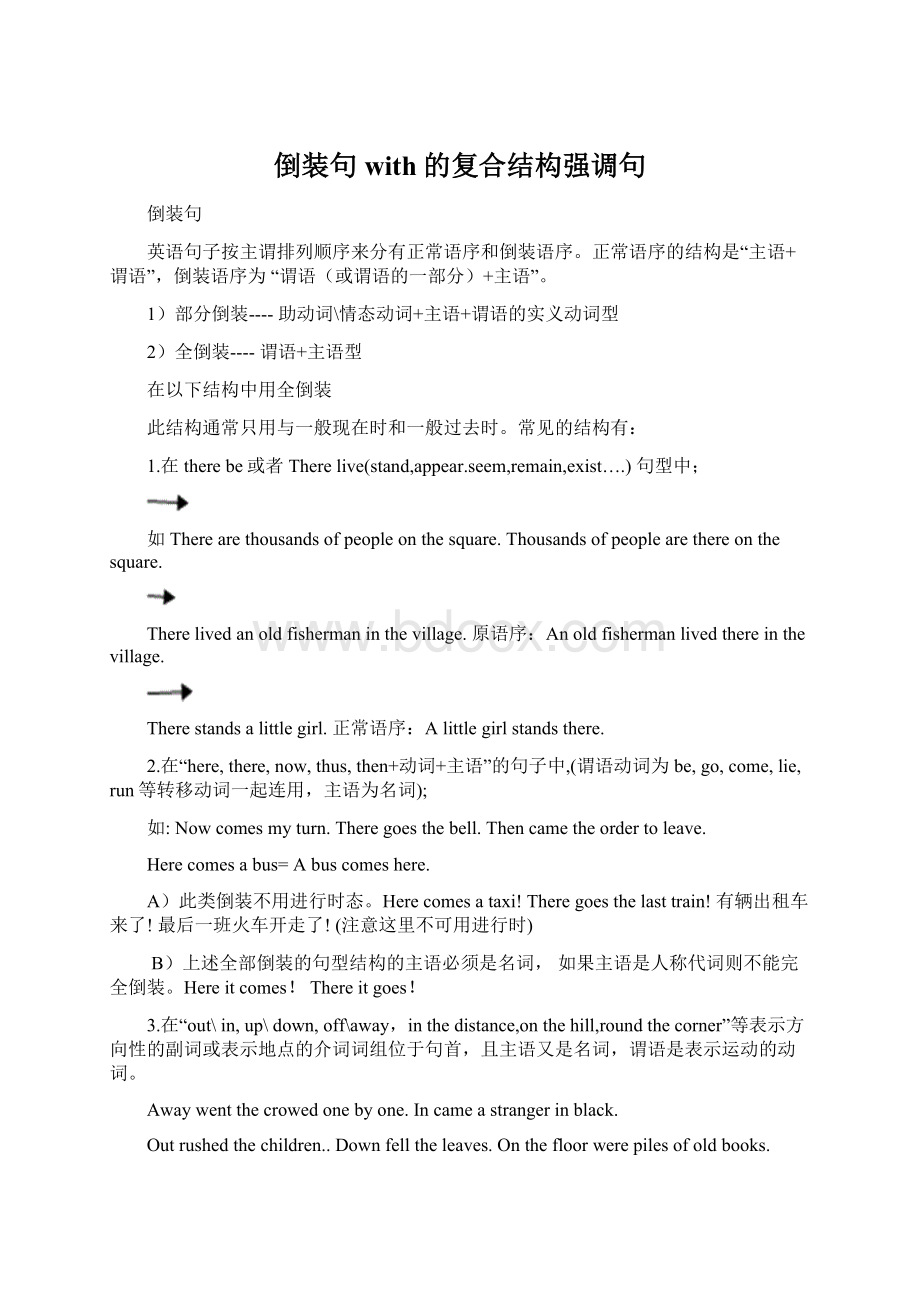倒装句with的复合结构强调句.docx
《倒装句with的复合结构强调句.docx》由会员分享,可在线阅读,更多相关《倒装句with的复合结构强调句.docx(13页珍藏版)》请在冰豆网上搜索。

倒装句with的复合结构强调句
倒装句
英语句子按主谓排列顺序来分有正常语序和倒装语序。
正常语序的结构是“主语+谓语”,倒装语序为“谓语(或谓语的一部分)+主语”。
1)部分倒装----助动词\情态动词+主语+谓语的实义动词型
2)全倒装----谓语+主语型
在以下结构中用全倒装
此结构通常只用与一般现在时和一般过去时。
常见的结构有:
1.在therebe或者Therelive(stand,appear.seem,remain,exist….)句型中;
如Therearethousandsofpeopleonthesquare.Thousandsofpeoplearethereonthesquare.
Therelivedanoldfishermaninthevillage.原语序:
Anoldfishermanlivedthereinthevillage.
Therestandsalittlegirl.正常语序:
Alittlegirlstandsthere.
2.在“here,there,now,thus,then+动词+主语”的句子中,(谓语动词为be,go,come,lie,run等转移动词一起连用,主语为名词);
如:
Nowcomesmyturn.Theregoesthebell.Thencametheordertoleave.
Herecomesabus=Abuscomeshere.
A)此类倒装不用进行时态。
Herecomesataxi!
Theregoesthelasttrain!
有辆出租车来了!
最后一班火车开走了!
(注意这里不可用进行时)
B)上述全部倒装的句型结构的主语必须是名词,如果主语是人称代词则不能完全倒装。
Hereitcomes!
Thereitgoes!
3.在“out\in,up\down,off\away,inthedistance,onthehill,roundthecorner”等表示方向性的副词或表示地点的介词词组位于句首,且主语又是名词,谓语是表示运动的动词。
Awaywentthecrowedonebyone.Incameastrangerinblack.
Outrushedthechildren..Downfelltheleaves.Onthefloorwerepilesofoldbooks.
☆注意:
主语必须是名词
eg:
Outshewent.Theretheyare.Herehecomes.而Outwentthegirl.Herecomestheboy.
地点状语后面如有表示位置的动词(如lie,live,sit,stand)或转移的动词(如come,go,rise),用作主语的名词可以放在动词之后。
这种情形主要出现在描写文中。
如:
Atthetopofthehillstoodthetinychapel.那座小教堂矗立在山顶上。
Inthefieldsofpoppieslaythedyingsoldiers.罂粟地里躺着奄奄一息的士兵们。
别的动词如属被动语态也可以倒装。
Inthedistancecouldbeseenthepurplemountains.远处可以见到紫色的山。
主语如是代词则不能倒装:
Atthetopofthehillitstoodoutagainstthesky.它背衬青天矗立在山顶上。
有时为了强调或者为了使句子平衡或者为了使上下文连接得更加紧密,就将表语和地点状语(多为介词短语)置于句首,谓语动词也常置于主语前,构成完全倒装。
如:
Bythedoorstoodanarmedguard.门口站着一名手持武器的士兵。
Atthenexttablewasaprettygirlwaitingforsomeone.隔壁桌上坐着一个等人的漂亮姑娘。
AmongthesepeoplewashisfriendJim.他的朋友吉姆就在这些人当中。
Bythewindowsatayoungmanwithamagazineinhishand.窗户边坐着一个年轻人,手里拿着一本杂志。
Atthefrontofthebookisatableofcontents,givingdetailsofwhatisinthebook.书的前部有目录,详列了书中的内容。
在以下结构中用部分倒装
部分倒装是指将谓语的一部分如助动词或情态倒装至主语之前。
如果句中的谓语没有助动词或情态动词,则需添加助动词do,does或did,并将其置于主语之前。
1.用于疑问句中。
如:
1)Howareyoudoing﹖2)Didyouseethefilmyesterday﹖
2.含有否定或半否定意义的词语(如:
not,never,seldom,hardly,little,scarcely,barely,few…);或者含有否定意义的连词(notonly…butalso..,neither..nor..,nosoonerhad…than...(一...就...),scarcely..than..,Hardlyhadwhen..,notuntil...;nowhere等);或否定意义的介词词组(bynomeans(决不),innocase\way(任何情况下都不),withnomethod,atnotime(决不),onnoaccount(决不),undernocircumstances\condition...(任何情况下都不))位于句首eg:
Ihaveneverseenhimbefore.=NeverhaveIseenhimbefore.
Notaworddidhesaywhenheleft.Seldom/Scarcelydoeshegotothatpark.
Hardly(几乎不)doIspeaktohim.LittleEnglishcanhespeak.
Littledoesherealizetheimportanceofthemeeting.FewpeopledidIseeinthestreet.
含有否定意义的连词:
eg:
1)Notonlycanheplaybasketball,butalsoIcan.2)Nosoonerhadwearrivedhomethanitbegantorain.3)Hardlyhadwemetourfriendswhenthetrainleft.
4)Notuntilthebabyfellasleepdidthemotherleavetheroom.(主句倒装,从句不倒装)
=Themotherdidn’tleavetheroomuntilthebabyfellasleep.
注意:
1)Notonly...butalso...必须连接两个分句时,才使用部分倒装。
而且只倒装notonly后的分句。
如果连接的是两个并列词语,不用倒装结构。
如:
NotonlyhisfatherbutalsoIlikereading.notonly…butalso…前后连接两个句子时,notonly后的句子要用部分倒装,但butalso后的分句不用倒装。
如:
Notonlydidhecome,buthesawher.他不仅来了,而且还见到了她。
Notonlyisheateacher,butheisalsoapoet.他不仅是一位教师,而且是一位诗人。
Notonlydidhespeakmorecorrectly,buthespokemoreeasily.不仅他讲得更正确,也讲得更不费劲了。
Notonlydidtheypresentamusicalperformance,buttheyalsogaveabriefintroductiontothehistoryofWesternbrassinstruments.他们不但做了音乐表演,而且简短地介绍了西方铜管乐器的历史。
2)当notuntil(直到...才)引导主从复合句时,主句倒装,从句不用倒装,或者可以理解为“后倒前不倒(装)”。
1.Notonly___,buthehimselfwasbadlybeatenup.
A.washerobbedeverythinghehad
B.everythinghehadwasrobbedof
C.hadeverythinghehadbeenrobbedof
D.washerobbedofeverythinghehad
2.IfinallywasadmittedtoBeijingUniversity.Neverinallmylife___sohappy.
A.IfeltB.didIfeelC.IhadfeltD.hadIfelt
3.Nosooner___tosleepthanthetelephonerangoncemore.
A.shewentB.shehadgoneC.didshegoD.hadshegone
4.Hardly___towritethecompositionwhenthebell___.
A.hadIbegun;rangB.Iwasbeginning;rang
C.hadIbegun;wasringingD.Iwillbegin;rings
5.Notuntiltheearlyyearsofthe19thcentury___whatheatis.
A.mandidknow B.manknow
C.didn'tmanknow D.didmanknow
含有否定意义的介词词组:
如:
Bynomeansshouldwetelllies.Onnoaccountshouldwelethimleave.
Atnotime决不willIgetmarriedtoyou.In[Under]nocircumstanceswillIlendmoneytohim.
注意:
innotime(立即,马上)位于句首时,其后无需用倒装语序:
Innotimeheworkedouttheproblem.他马上就算出了那道题。
3.only+副词;或介词短语;或状语从句时,主句倒装;
eg:
Onlyinthiswaycanyouusethecomputerwell.(only+介词短语)
Onlyyesterdaydidhefindoutthathiswatchwasmissing.(only+副词)
Onlywhenitbegantoraindidhefinishhisjob.(only+状语从句)
按英语习惯同,当“only+状语”位于句首时,其后句子要用部分倒装。
如:
Onlythendidherealizethathewaswrong.到那时他才意识到他错了。
Onlyinthiswaycanourhonourbesaved.只有这样,才能保住我们的荣誉。
OnlyafterherdeathwasIabletoappreciateher.只有到她死后我才认识到她的价值。
Onlywhenhereturnedhomedidherealizewhathadhappened.当他回到家里时,才知道出了什么事。
Onlybyshoutingwasheabletomakehimselfheard.他只有叫喊才能让别人听到他。
Onlywhenwelandeddidweseehowbadlytheplanehadbeendamaged.我们只是在着陆之后才看到飞机损坏的严重程度。
OnlyononepointdoIagreewithyou.只有一点,我同意你的说法。
1.Onlythen_________howmuchdamagehadbeencaused.
A.sherealizedB.shehadrealized
C.hadsherealizedD.didsherealize
2.Onlyaftermyfriendcame_________.
A.didthecomputerrepairedB.berepairedthecomputer
C.wasthecomputerrepairedD.thecomputerwasrepaired
特别说明:
有时命题者不是利用位于句首的“only+状语”来考查倒装,而是倒过来,利用给定的倒装结构来考查对only的选择。
如下面一题(答案选A):
_____bykeepingdowncostswillPowerDataholditsadvantageoverothercompanies.
A.OnlyB.JustC.StillD.Yet
4.so用在句首,表示另一主语“也...样”时,用“So+be(have,助动词或情态动词)+主语”结构;而表示另一主语“也不...样”时,用“Nor\Neither+be(have,助动词或情态动词)+主语”结构;注意:
若是对上文同一主语的情况进行肯定时,不倒装。
句型为“So+主语+be或do(did)/have”。
eg:
Hewenttoschoolyesterday,sodidI.
---Davidhasmadegreatprogressrecently.--Sohehas,andsohaveyou.
eg:
Hehasn'tfinishedhishomework,andnorhaveI.eg:
Ifyouwon'tgo,neither/norwillI.
当so引出的句子用以对上文内容加以证实或肯定时,不可用倒装结构。
意为“的确如此”。
1)TomaskedmetogotoplayfootballandsoIdid.
2)---It’sraininghard. ---Soitis.
1.---Davidhasmadegreatprogressrecently.
---_______,and_______.
A.Sohehas;soyouhaveB.Sohehas;sohaveyou
C.Sohashe;sohaveD.Sohashe;soyouhave
2.Maryneverdoesanyreadingintheevening,_________.
A.sodoesJohnB.Johndoestoo
C.Johndoesn’ttooD.nordoesJohn
so…that结构中的倒装。
有时要强调so所修饰的形容词或副词,常将so 连同它所修饰的形容词或副词一起提到句首.这时,主句要用部分倒装结构。
如:
1)Heransofastthathewasfaraheadofothers.
→Sofastdidherunthathewasfaraheadofothers.
Socleverishethathecanworkoutallthe difficultproblemsinthebook.
在so...that…结构中,若将so+adj./adv.置于句首,则其后的主句要用部分倒装。
如:
Somuchdidtheyeatthattheycouldnotmoveforthenexthour.
Soloudlydidhespeakthatevenpeopleinthenextroomcouldhearhim.他讲话声音那么大,隔壁屋里的人都听得见。
Sosuddenwastheattackthatwehadnotimetoescape.
类似地,当such…that…结构的such…置于句首时,such后的句子也要使用部分倒装。
如:
Suchanicemandidheseemthatweallbelievehim.他像个很和蔼的人,所以我们都喜欢他。
1.Soloudly___thateveryoneoftheclasscouldhearhim.
A.didhespeakB.didhespokeC.spokeheD.hespoke
2.Solittle___agreeontheplanthattheycouldnotsettletheirdifferences.
A.dotheyB.didtheyC.theydidD.theydidnot
3.Sodifficult_____ittoworkouttheproblemthatIdecidedtoaskTomforadvice
A.IdidfindB.didIfindC.IhavefoundD.haveIfound
4._________aboutwildplantsthattheydecidedtomakeatriptoMadagascarforfurtherresearch.
A.socuriousthecouplewas B.Socuriouswerethecouple
C.HowcuriousthecouplewereD.Thecouplewassuchcurious
5.—It’sburninghottoday,isn’tit?
—Yes._________yesterday.
A.SowasitB.SoitwasC.SoitisD.Soisit
6.—Maggiehadawonderfultimeattheparty.—___C______,andsodidI.
A.SoshehadB.SohadsheC.SoshedidD.Sodidshe
7.—Father,youpromised!
—Well,____D_____.Butitwasyouwhodidn’tkeepyourwordfirst.
A.sowasI B.sodidIC.soIwasD.soIdid
5.倒装句中的主谓一致
在“副词here,there,now,then,up,down,in,out,away等、作状语或表语的介词短语或分词短语+谓语动词+主语”的倒装结构中,谓语动词的数由动词后面的主语决定。
Onthewallhangtwomaps.墙上挂着两张地图。
Onthewallhangsaworldofmap.墙上挂着一张世界地图。
Hereisyourcoat.这是你的外套。
Hereareyourrunning-shoes.这是你的跑鞋。
Suchistheresult.结果就是这样Sucharetheresults.这就是结果。
例题讲解
1.考查never置于句首时的倒装
当否定副词never置于句首时,其后习惯上要用倒装语序(与一般疑问句形式相同)。
如:
(答案分别为B)
(1)Neverinmywildestdreams_________thesepeoplearelivinginsuchpoorconditions.(安徽卷)
A.IcouldimagineB.couldIimagine
C.Icouldn’timagineD.couldn’tIimagine
2.考查little置于句首时的倒装
当否定副词little置于句首时,其后习惯上要用倒装语序(与一般疑问句形式相同)。
如:
(答案分别为D)
(1)Little_________thatwewerewatchinghiseverymove,soheseemedtobegoinghisownwayinthisbusiness.(安徽卷)
A.herealizedB.hedidn’trealize
C.didn’therealizeD.didherealize
3.考查seldom置于句首时的倒装
当否定副词seldom置于句首时,其后习惯上要用倒装语序(与一般疑问句形式相同)。
如:
(答案分别为B)
(1)Seldom_________anyapologywhenmistakesaremade.
A.wereceiveB.dowereceive
C.wereceivedD.didwereceive
4.考查hardly/scarcely置于句首时的倒装
当否定副词hardly,scarcely等置于句首时,其后习惯上要用倒装语序(与一般疑问句形式相同)。
如:
(答案为A)
Hardly_________EdinburghthantheywereorderedtoreturntoLondon.
A.hadtheyreachedB.theyhadreached
C.havethereachedD.theyhavereached
5.考查nosooner等置于句首时的倒装
当no